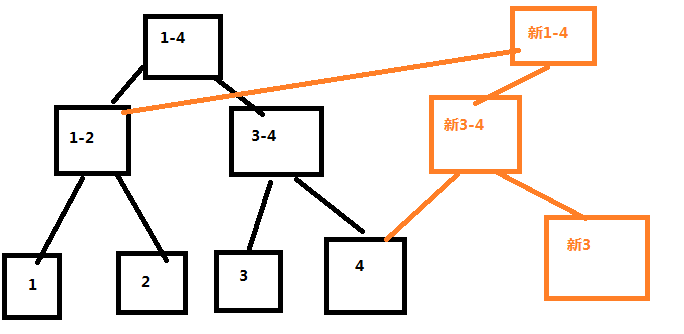可持久化1——主席树(可持久化线段树)
简介
主席树就是可持久化线段树,它的作用就是不停地访问某个历史版本,时间复杂度为O((n+m)logn)。
题目
洛谷3919(https://www.luogu.com.cn/problem/P3919)
如题,你需要维护这样的一个长度为 N 的数组,支持如下几种操作
-
在某个历史版本上修改某一个位置上的值
-
访问某个历史版本上的某一位置的值
此外,每进行一次操作(对于操作2,即为生成一个完全一样的版本,不作任何改动),就会生成一个新的版本。版本编号即为当前操作的编号(从1开始编号,版本0表示初始状态数组)
分析
先看看暴力做法:每次单点修改一个节点(数组模拟比线段树少一只log),然后存入一个新的版本里。时间复杂度为O(nm),空间O(nm)。
这显然在洛谷你会看见一堆黑色(MLE+TLE)
这显然不可取,那我们有什么更好的做法吗?
主席树原理
我们观察,线段树的单点修改应该是这样的,比如我们要修改3号节点

我们发现,其实当我们进行线段树上单点修改时,只会修改红色路径上的点,而修改的点是log(n)个,也就是我们要新建log(n)个节点。

修改如上图:
主席树的一些特性:
1、主席树的根很多很多,且每个根都有一颗完整的线段树。
2、每一个节点的父亲都不止一个。
操作
接下来,一起收菜(It's show time)。
定义
我们要定义一个结构体,这个结构体需要存三个量,权值val,左儿子lson,右儿子rson。
为什么要存左右儿子?
因为我们这是主席树,要动态开点,已经不是线段树的左儿子为根*2,右儿子为根*2+1了。
1 2 3 | struct tree{ int lson,rson,val;}t[MAXN*20]; |
需要注意的是,这里的数组要开N的20倍大小。
建树
建树十分简单,和线段树基本一样。注意,这里用了动态开点。
1 2 3 4 5 6 7 8 9 10 11 | void build(int &rot,int l,int r){//细心的你会发现这个rot是用了取址符的,意味着你只要改了rot,原来你弄进去的变量也会改 rot=++tot;//动态开店 if(l==r){ t[rot].val=n[l]; return; } int mid=l+r>>1; build(t[rot].lson,l,mid);//这里可以直接写t[rot].lson,因为用了取址符 build(t[rot].rson,mid+1,r);// t[rot].val=t[t[rot].lson].val+t[t[rot].rson].val;本题不用,本题不用求历史版本区间和} |
修改
修改操作时,我们先把当前节点copy一份,出来的就是上面图的橙色节点,连的都还是原来的左右儿子。
然后我们判断我们修改的节点是在左子树还是在右子树,然后不停地递归下去。
1 2 3 4 5 6 7 8 9 10 11 12 13 14 15 | void clone(int &rot,int cl){ rot=++tot; t[rot]=t[cl];}void update(int &rot,int l,int r,int cl,int loc,int value){//这里的rot依然用的是有取址符的 clone(rot,cl);//克隆一份 if(l==r){ t[rot].val=value; return; } int mid=l+r>>1; if(loc<=mid)update(t[rot].lson,l,mid,t[cl].lson,loc,value);//这里的t[rot].lson和t[cl].lson不要搞错 if(loc>mid)update(t[rot].rson,mid+1,r,t[cl].rson,loc,value);//同上 // t[rot].val=t[t[rot].lson].val+t[t[rot].rson].val;本题不用,本题不用求历史版本区间和} |
查询
查询就很容易了,简直就是线段树一样。
1 2 3 4 5 6 | int Find(int rot,int l,int r,int loc){ if(l==r)return t[rot].val; int mid=l+r>>1; if(loc<=mid)return Find(t[rot].lson,l,mid,loc); else return Find(t[rot].rson,mid+1,r,loc);} |
代码
1 2 3 4 5 6 7 8 9 10 11 12 13 14 15 16 17 18 19 20 21 22 23 24 25 26 27 28 29 30 31 32 33 34 35 36 37 38 39 40 41 42 43 44 45 46 47 48 49 50 51 52 53 54 55 56 57 | #include<bits/stdc++.h>using namespace std;const int MAXN=1000005;int N,M,n[MAXN],tot,rt[MAXN],v,loc,c,value;struct tree{ int lson,rson,val;}t[MAXN*20];void build(int &rot,int l,int r){ rot=++tot; if(l==r){ t[rot].val=n[l]; return; } int mid=l+r>>1; build(t[rot].lson,l,mid); build(t[rot].rson,mid+1,r);// t[rot].val=t[t[rot].lson].val+t[t[rot].rson].val;本题不用,本题不用求历史版本区间和}void clone(int &rot,int cl){ rot=++tot; t[rot]=t[cl];}void update(int &rot,int l,int r,int cl,int loc,int value){ clone(rot,cl); if(l==r){ t[rot].val=value; return; } int mid=l+r>>1; if(loc<=mid)update(t[rot].lson,l,mid,t[cl].lson,loc,value); if(loc>mid)update(t[rot].rson,mid+1,r,t[cl].rson,loc,value); // t[rot].val=t[t[rot].lson].val+t[t[rot].rson].val;本题不用,本题不用求历史版本区间和}int Find(int rot,int l,int r,int loc){ if(l==r)return t[rot].val; int mid=l+r>>1; if(loc<=mid)return Find(t[rot].lson,l,mid,loc); else return Find(t[rot].rson,mid+1,r,loc);}int main(){ scanf("%d%d",&N,&M); for(int i=1;i<=N;i++) scanf("%d",&n[i]); build(rt[0],1,N); for(int i=1;i<=M;i++){ scanf("%d%d%d",&v,&c,&loc); if(c==1){ scanf("%d",&value); update(rt[i],1,N,rt[v],loc,value); } if(c==2){ printf("%d\n",Find(rt[v],1,N,loc)); rt[i]=rt[v]; } } return 0;} |
总结
主席树还是很容易的,只要你看的懂的话,这是本萌新第一次写博客,有什么建议可以在下面提,或私聊。
本文作者:天穹の流星
本文链接:https://www.cnblogs.com/Bronya19C/p/12374296.html
版权声明:本作品采用知识共享署名-非商业性使用-禁止演绎 2.5 中国大陆许可协议进行许可。





【推荐】编程新体验,更懂你的AI,立即体验豆包MarsCode编程助手
【推荐】凌霞软件回馈社区,博客园 & 1Panel & Halo 联合会员上线
【推荐】抖音旗下AI助手豆包,你的智能百科全书,全免费不限次数
【推荐】博客园社区专享云产品让利特惠,阿里云新客6.5折上折
【推荐】轻量又高性能的 SSH 工具 IShell:AI 加持,快人一步